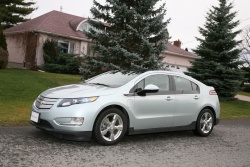 2012 Chevrolet Volt; photo by James Bergeron. Click image to enlarge |
By Paul Williams
Recently, I was behind the wheel of that eco-transport marvel, the Chevrolet Volt. It’s a fascinating car for many reasons, not the least of which is that General Motors actually pulled it off. Here it is, ready to go, and although it differs somewhat from the initial concept presented at the 2007 Detroit auto show, the company should be congratulated on its achievement.
In the intervening years, however, some very interesting things have been happening with “eco” vehicles, which maybe the Volt’s originators anticipated.
Hybrids, especially, are hitting a wall (figuratively, that is) with their fuel consumption numbers and their price. Many now deliver fuel consumption below 5.0 L/100 km (according to the official estimates (Canada’s official fuel consumption estimates are facing criticism for being 15-25 percent too generous, according to the Automobile Protection Agency. “Real world” experience may not match the numbers given in this article), but prices are still hovering between $24,000 – $40,000 or more. Inquiring minds want to know: for mainstream consumers… just how much more fuel efficient and economical can hybrid family transportation become? Are we at its limit? And if so, given new developments with “traditional” gasoline engines, what does that mean for hybrids in general?
 2006 Honda Insight; photo by Peter Bleakney. Click image to enlarge |
After all, just over a decade ago, the official fuel consumption estimate for Honda’s Insight hybrid was 3.9L/100 km (the Insight was the world’s most fuel efficient production car for years, and Honda arguably kept building it for that reason alone). But the Insight was a little two-seat vehicle, super-lightweight, with polarizing design and possessing nowhere near the crash-resistance and convenience items that governments and consumers now require.
However, twelve years later, 3.9L/100 km is still amazing fuel economy, so it’s a huge achievement to even come close to that level in much heavier, larger vehicles that satisfy modern crash test and recycling requirements, accommodate five people and their cargo, include navigation systems, multiple airbags, premium interiors and other conveniences that we all now want in our vehicles. And, of course we want the price down, too.
As optimistically — and, it turns out, correctly — predicted a decade ago, there are several such vehicles on the market now, and hybrids have led the way. Toyota’s Camry Hybrid (5.7/4.7L/100km) and Prius (3.7/4.0), the Honda Civic Hybrid (4.7/4.2) and the Kia Optima/Hyundai Sonata hybrid sedans (5.5/4.6) are examples.
 2010 Toyota Prius; photo by Chris Chase. Click image to enlarge |
But an emerging issue for hybrids (some might say the issue) is the comparatively recent introduction by many manufacturers of new gasoline direct injected engines (GDIs), some turbocharged, that make ridiculous amounts of horsepower and torque, sip fuel like it’s the non-renewable resource that it is, and possess ultra-low emissions vehicle (ULEV) and even partial zero emissions (PZEV) credentials. The use of these engines is becoming widespread in mainstream vehicles, especially from automakers that are not wedded to hybrids, and many can be bought for less than an equivalent hybrid. What will be the impact of this technology on the proliferation of hybrids in the future?
And yes, I know there are diesels to consider. We’ll get to those.
However, to backtrack a little, it was also suggested a decade ago that hybrid vehicles were a transitional technology, maybe leading to hydrogen-powered cars that were expected around 2010. Clearly we’re not seeing hydrogen powered cars yet, and talk of hydrogen by car manufacturers has died down to a whisper these days, if it is mentioned at all. But along with the hydrogen conversation, many in the industry were also voicing the opinion that there is life yet in the internal combustion engine (ICE), and that the simplest “solution” to emissions and fuel efficiency (and dependency) issues is to further refine this tried and true technology.









